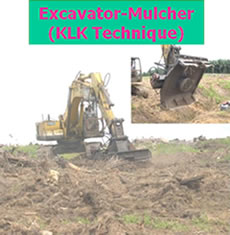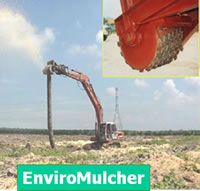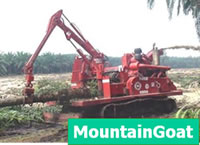Oil Palm: Replanting
Some pulverisation techniques of clearing old oil palms for replanting
- Chip and burn (open burning has been banned)
- Chip and windrow
- Chip-windrow and pulverize when palm chips have partially decayed
- Poison and under-plant
Why do we need improved methods of clearing old palms for replanting?
- The ban on open burning resulted in very high breeding of rhinoceros beetles, now the most serious pest in immature and young mature palms in Malaysia
- Liau et al . (1991) reported crop loss of up to 40% in the first year of harvest at 50% beetle damage incidence
- Chung et al . (1999) reported that severe beetle damage could result in 92% loss of the first 12 months’ crop
- Windrowed palm residues hindering field operations
- Nutrients in windrowed palm residues not readily available to replanted palms until the palm roots have reached the windrows
- Windrowed palm residues harbouring and breeding rats
1. Telok Sengat Estate method (tractor-mulcher)
-
The entire palm is pulverized into small pieces and spread widely over the field and the root mass around the bole dug up during land clearing .
-
Tractor-Mulcher pulverising 40-day old chips
-
Tractor ploughing up missed and partially pulverised chips
-
Second round pulverisation after ploughing
-
Field condition after 2 rounds of pulverisation and a round of ploughing in between

2. KLK method (excavator-mulcher)
-
Excavator fell and chip palm and spread chips into single-palm heaps
-
Excavator-Mulcher™ pulverizing 2-month old palm chips

Three techniques for pulverising the standing and newly felled palms
Technique 1. The EnviroMulcher™
-
Cylindrical steel drum with 111 pieces tungsten carbide knives and mounted at the excavator’s boom. It is driven by the hydraulic system of the excavator
-
Pulverizing a fallen trunk including the crown
-
A supporting excavator digs up root mass and stacks fronds

Technique 2. The MountainGoat™
-
Powered by a 750hp caterpillar engine and supported by 2 excavators
-
Two excavators fell and line palms for a MountainGoat™
-
The same excavators also dig up root mass
-
MountainGoat™ chipper drum with 10 knives

Technique 3. The Beaver™
-
Powered by a 300 hp caterpillar engine
-
Severing root mass with blade
-
Beaver felling palm
-
Rotating drum with 20 pieces self-sharpening flails pulverizing felled palms
-
Pulverizing a felled palm
-
Mulching a newly planted palm
-
Mulching newly replanted palm circle with freshly pulverised chips produced by EnviroMulcher™ improves palm growth significantly

Conclusions
The major problems associated with the conventional methods of land clearing could be overcome or minimized by pulverizing and spreading the palm biomass widely over the field during land clearing prior to the planting of palms and legume cover crops
References
Ooi L.H. and Heriansyah 2005. Palm pulverization in sustainable oil palms replanting. Plant Production Science 8 (3) : 345-348.
Ooi, L.H., Kodiappan, P. and Gunarajan, M. 2004. Some pulverisation techniques of clearing old palms for replanting. Proc. National Seminar on Replant or Perish. Incorporated Society of Planters, Kuala Lumpur: 47-63.
Chung, G. F., Sim, S. C. & Balasubramaniam, R. (1999). Effects of pest damage during immature phase on the early yields of oil palm. In 1999 PIPOC Proceedings: Emerging Technologies and Opportunities in The Next Millennium. Palm Oil Research Institute of Malaysia, Kuala Lumpur, pp 454-476.
Liau, S. S. & Ahmad Alwi. (1991). The control of Oryctes rhinoceros by clean clearing and its effect on early yield in palm-to-palm replants. In: 1991 PORIM Int. Palm Oil Conf. pp 396-403.
(Movies and photos contributed by Ooi Ling Hoak, unpublished)
